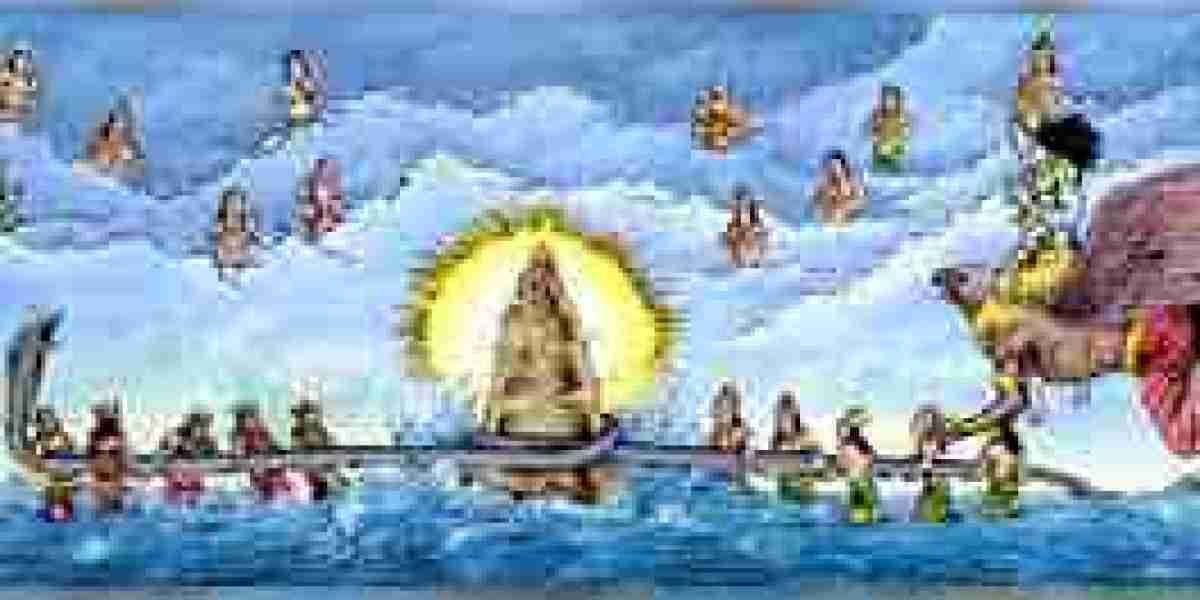The Samudra Manthan (Churning of the Ocean) is one of the most significant events in Hindu mythology, symbolizing the eternal struggle between good and evil. The story is recounted in the Mahabharata and Bhagavata Purana, where gods (Devas) and demons (Asuras) churn the cosmic ocean to obtain valuable treasures or Ratnas. These Ratnas, a collection of divine gems and objects, not only hold immense spiritual and symbolic significance but also represent the quest for both material and spiritual wealth.
In this article, we will delve deep into the list of Ratnas from Samudra Manthan, their significance, and the fascinating stories behind each one. This exploration will not only highlight the cultural importance of these Ratnas but also provide valuable insights into their role in ancient Hindu mythology.
Understanding Samudra Manthan: A Mythological Overview
The Samudra Manthan was initiated when the gods and demons decided to collaborate in churning the ocean to obtain Amrita, the nectar of immortality. They used Mount Mandara as the churning rod and the serpent Vasuki as the rope to churn the ocean's depths. What emerged from the ocean was a treasure trove of divine objects, Ratnas, and beings, each with its own distinct powers and significance.
This churning is a metaphor for the ongoing struggle between good (Devas) and evil (Asuras), with the ocean representing the mind and its inner depths. As the churning process unfolds, the Ratnas symbolize various virtues, knowledge, and power that one can attain by overcoming obstacles and aligning with righteousness.
The List of Ratnas from Samudra Manthan
The churning of the ocean produced numerous valuable Ratnas. Here, we explore each of these divine treasures and their deeper meanings:
1. Amrita (Nectar of Immortality)
The most coveted of all the Ratnas, Amrita, symbolizes immortality and divine grace. It is the nectar that grants eternal life to anyone who drinks it. In the myth, both the gods and demons vie for possession of Amrita, leading to a fierce battle. This divine nectar represents the ultimate goal of human life — attaining eternal happiness and liberation from the cycle of life and death (samsara).
2. Kalpavriksha (The Wish-fulfilling Tree)
Emerging from the ocean, the Kalpavriksha is a divine tree that fulfils any wish. This tree is symbolic of prosperity, abundance, and the fulfilment of desires. It signifies that, when one aligns themselves with cosmic order and righteousness, all their material and spiritual needs are met. The Kalpavriksha is often seen as a metaphor for the ideal state of existence — a life free of suffering and full of blessings.
3. Kamadhenu (The Divine Cow)
Another precious gem from the churning is Kamadhenu, the wish-fulfilling cow. Kamadhenu can provide endless supplies of milk, butter, and other sustenance, representing nourishment, prosperity, and fertility. This Ratna also embodies the notion that divinity ensures the welfare and sustenance of all beings. Kamadhenu’s ability to provide endlessly speaks to the self-sustaining nature of the universe and the infinite love of the divine.
4. Airavat (The White Elephant)
Out of the ocean rose Airavat, a magnificent, white elephant that symbolizes strength, power, and royalty. Airavat, often associated with Lord Indra, is the king of all elephants. It represents not only physical strength but also mental and spiritual power, the ability to conquer obstacles, and the might to uphold righteousness (Dharma). This divine creature is also a symbol of divine protection and support.
5. Uchhaishravas (The Seven-headed Horse)
The Uchhaishravas, a seven-headed celestial horse, is another remarkable Ratna that emerged from the churning. It is a symbol of royalty, speed, and grace. Uchhaishravas is said to possess the ability to travel across the heavens, embodying the spiritual journey that one undertakes in search of higher wisdom and divine enlightenment.
6. Lakshmi (The Goddess of Wealth)
Lakshmi, the goddess of prosperity, wealth, and fortune, is a prominent Ratna from Samudra Manthan. Emerging from the ocean, she bestows material success, health, and well-being to those who seek her blessings. Lakshmi’s presence in the myth underscores the significance of wealth in maintaining balance and harmony in life. She represents both material and spiritual abundance, teaching that true wealth lies in aligning with the divine.
7. Varuni (The Goddess of Wine)
Another interesting Ratna that emerged from the churning is Varuni, the goddess of wine. Varuni represents pleasure, indulgence, and the balance between the material and spiritual realms. In Hindu mythology, wine is symbolic of indulgence in the pleasures of life, but it must be consumed with wisdom and restraint to avoid overindulgence and maintain spiritual discipline.
8. Dhanvantari (The Physician of the Gods)
Dhanvantari, the divine physician, emerged from the churning holding the pot of Amrita. He is the embodiment of health, well-being, and healing. Dhanvantari is considered the originator of Ayurveda, the ancient system of medicine. He is revered as the deity who protects physical and mental health, symbolizing the essential role of health in a balanced life. His appearance from the ocean represents the universal truth that health is the foundation of prosperity and longevity.
9. Purna Kumbha (The Sacred Pot of Nectar)
The Purna Kumbha, a sacred pot containing Amrita, is one of the most spiritually significant Ratnas to emerge from the ocean. This vessel holds the nectar of immortality and is a symbol of the ultimate pursuit — attaining eternal life and freedom from suffering. The Purna Kumbha represents the human soul’s potential for divine union and the realization of one's highest self.
10. Sharanga (The Divine Bow of Vishnu)
The Sharanga is the divine bow wielded by Lord Vishnu. It represents protection, righteous warfare, and the power to destroy evil. Sharanga is a symbol of the divine intervention that protects dharma (cosmic order) and upholds justice in the world. It signifies the tools and weapons necessary to fight against dharma (unrighteousness) and to bring balance to the universe.
Symbolism and Significance of the Ratnas in the Samudra Manthan
Each of the Ratnas that emerged from the churning of the ocean holds deep symbolic meaning in Hindu philosophy. Collectively, they represent the ultimate union of the material and spiritual worlds. These Ratnas are not mere objects; they are metaphors for the divine attributes and values that humans should strive to embody. From immortality and prosperity to knowledge and wisdom, the Ratnas serve as powerful reminders of the rewards that await those who follow the path of righteousness and self-realization.
The Deeper Message: Churning for Spiritual Enlightenment
While the literal churning of the ocean is a fantastic tale filled with gods, demons, and treasures, it also serves as an allegory for the process of spiritual enlightenment. Just as the ocean must be churned to reveal its treasures, the human mind and soul must be churned through discipline, devotion, and meditation to uncover higher truths and divine wisdom.
Conclusion
The Samudra Manthan and the Ratnas that emerged from it continue to be central to Hindu mythology and spirituality. These divine treasures symbolize the various aspects of life that one can aspire to, from physical health and material wealth to spiritual enlightenment and immortality. Understanding these Ratnas helps us recognize the deeper significance of the mythological tale and its timeless relevance in our lives.
By contemplating these Ratnas and their symbolism, one can understand the nature of existence and the importance of striving for balance between the material and spiritual realms.




